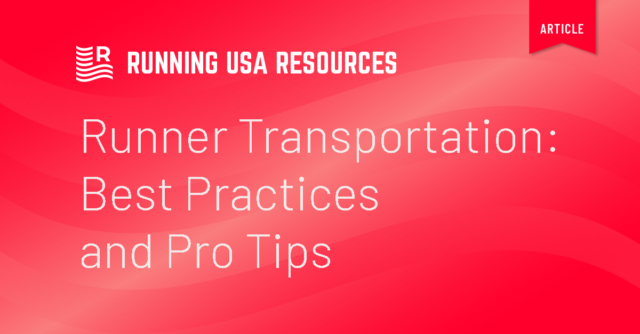By Doug Thurston
Race-day transportation is an important part of the weekend plan for many races and also can be a significant race expense, often running into the hundreds of thousands of dollars. Providing race-morning transportation is standard with point-to-point courses and may also be used where parking is an issue at the start or finish venues. Since transportation is often the first and last touchpoint for runners on race day, an effective program can avoid adding extra stress to what is already an anxious morning for entrants.
There are as many transportation plans as there are races that use them. An example of one of the most complex but successful programs is that used by the Big Sur Marathon. The iconic event features six different races on scenic and hilly Highway 1 on the Central California coast. The road that is the course is the only option to get to the start(s) and is closed to the general public race morning. There is no runner parking or drop off at any of the start areas.
Elements of the program include:
• Securing 170-plus buses from multiple vendors including school districts and charter companies.
• Transporting close to 7,000 runners from 10 different pick-up locations to six different starting lines or relay transition areas all between 3:30 and 6 a.m.
• Since all buses travel the same route as the races, final course set-up can’t really take place until most buses have dropped off their runners and returned north past the finish line, necessitating the early start.
• Many of the same buses are used to transport runners from the finish village back to their morning pick-up location after the race (there is limited parking in the finish area and no buses depart from there).
The Big Sur transportation team has refined their plan over three decades. Here are some of the things they have learned that might help with other races:
• Accurate record keeping is crucial: The Big Sur team is fortunate that all race distances sell out months early with typically the same entry caps, generating years of data. This helps with ordering and staging the right number of buses at each location.
• All shuttled runners visit the transportation desk at the expo after collecting their bib to chat with experienced volunteers who distribute pre-numbered bus tickets for each location.
• Where a runner boards their bus is determined by several factors including where they are staying the night before the race, if they plan to park a car at the shuttle location, and when they come to the expo.
• Runners are issued numbered paper tickets at the desk for their pick-up location. This “count-down” approach helps the transportation team know real-time bus capacity and move buses around Saturday afternoon, if needed, to meet demand.
• The race doesn’t ask runners to reserve a pick-up location before race weekend: many runners don’t know where they are staying when they register so the data collected would be of limited use. The historical data has proven far more useful. And there is nothing like face-to-face interaction to clarify the right place and time to show up race morning to catch the shuttle.
Here are some other tips and ideas for race day that can help your program:
• It’s natural that runners want to try to take the latest bus possible in hopes of catching a few more minutes of sleep. Build your schedule based on what your race needs to get everyone to the start(s) in plenty of time and clear the roads, if needed, for proper race set-up.
• When in doubt, start the buses earlier if your start venue can be ready to receive runners.
• Have a heavy-duty tow truck on standby if needed as well as an extra bus or two in case of an early-morning breakdown or other incident.
• Make sure your race-morning pick-up locations are clearly signed (with lighted signs, if possible) and provide accurate maps online and/or at the expo (with cross streets or addresses for early-morning phone navigation).
• Use plenty of reflective cones and outfit your volunteers with reflective vests, flashlights or glow sticks.
• Make sure there are trashcans, recycle bins, and toilets at all pick-up locations; if the same locations are used after the race, make sure there is a plan to empty the trashcans and recycle bins between the race start and finish.
• Online reservations can work well, particularly if you are charging for race-day transportation. Work with your registration company to design an effective system and make sure your refund policy is clear if a runner does not attend the race.
• Are spectators, friends, family or volunteers allowed on the buses? Make sure this policy is very clear.
• How will runners board the buses? Show bib numbers? A ticket? A QR code on their phone? Develop a system that is most efficient race morning in the dark.
• If your race requires a long ride to the start, a point-to-point marathon, for example, suggest that runners avoid drinking excess coffee or water before they board the bus unless you are using coaches with bathrooms on board.
• Clearly explain your policy about bringing bags on board and have extra signage race morning at the bus loading area.
• Some races put signs on each bus clearly indicating who is to board or what start line the bus is going. Work closely with the bus company to determine what size works best and the right way to attach signs race morning.
• Will you have volunteers riding on each bus to make announcements? Will the bus company play pre-recorded announcements during the drive? Both practices are rare but they are a nice way to share some tips about what runners can expect when they get off the bus at the start village and during the race.
• Consider if you need special transportation for Athletes with Disabilities. Many races have special buses for their AWD athletes to use their travel chairs and a separate vehicle to carefully strap in their high-end racing chairs.
• If your race is a longer point-to-point event, do you need buses and/or box trucks to transport bike marshals and their bikes, medical teams and carts, entertainment groups, or other volunteers?
• Provide hand-clicker counters to volunteers who help load runners to make sure there are no empty seats.
• Provide radios to key transportation volunteers and ask them to check in with forward command on the status of first and last buses.
• Have a complete debrief with the transportation team and note any constructive comments in post-race runner surveys that can help planning for your next race.
• Ask your key transportation volunteers to consider helping at other races or community events that feature transportation programs (fairs, concerts, conventions, sporting events, etc.). There is always something to learn seeing how other events move people safely and efficiently.
The best race-day transportation programs are easy for runners to understand, follow, and use. I hope some of these ideas can be useful. There are likely numerous additional resources in your community with municipal transportation agencies, school districts, and even full-time transportation consultants. And, of course, reach out to your fellow race directors. We are here to help!
Doug Thurston is a World Athletics/AIMS Level A measurer and has certified more than 100 courses throughout the country. He has also been a race director for 40 years managing races large and small including the Tulsa Run, Columbus Marathon, and the Big Sur International Marathon. He continues to measure courses and consult and assist with course and race operations from his home in Santa Fe, New Mexico. He can be reached at tallrunnerdoug@gmail.com.
large and small including the Tulsa Run, Columbus Marathon, and the Big Sur International Marathon. He continues to measure courses and consult and assist with course and race operations from his home in Santa Fe, New Mexico. He can be reached at tallrunnerdoug@gmail.com.

